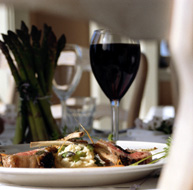Restaurant Menu Makeover
 Over the past two years we have seen several major chain restaurants posting calories on their menus. Legislation on posting calories on menus was passed with the hopes that seeing the calories of certain menu items would hopefully encourage people to make healthier choices when dining out. A recent US study took this idea one step further.
Over the past two years we have seen several major chain restaurants posting calories on their menus. Legislation on posting calories on menus was passed with the hopes that seeing the calories of certain menu items would hopefully encourage people to make healthier choices when dining out. A recent US study took this idea one step further.
A survey questioned 802 middle-aged women to imagine they were in a fast food restaurant and were choosing a meal to order. Each group was given a different menu: one with calorie information, one with calorie information and minutes of walking required to burn those calories, one with calorie information and the miles of walking required to burn off the calories, and one with no nutritional information. Researchers found that when the amount of minutes a person would have to walk to burn off the meal was posted along with the calorie information, the average meal people chose had a lower caloric content than when the calories alone were posted.
The researchers also asked participants to answer a questionnaire regarding their knowledge of calories. The results showed that even though 96% of the participants were educated at a college or university level, only 8% answered all the questions correctly. This shows that people need more education when it comes to the number of calories in their food, especially when it comes to eating out.
Results of these surveys provide a strong argument for posting information on menus such as minutes of walking required to burn off a meal. On average, one mile walked burns 100 calories. Let’s say at an average walking pace, it takes you about 20 minutes to walk a mile. An average single burger patty and small french fries ordered at a fast food chain is roughly 500 calories. That means, you would have to walk for 100 minutes (1 hour and 40 minutes) just to burn off a burger and small french fries. It is likely that 100 minutes of physical activity would impact people more than seeing 500 calories.
Here are some tips for ordering food at a restaurant.
Portion distortion: Just because something is meant for one person at a restaurant does not mean that it should be. Try sharing dishes so that you are only eating a fraction of the calories the whole dish contains.
Sauce on the side: Restaurants have a tendency to use a lot of salt as a flavoring agent in sauces and dressings. Ask for food to be made without salt or “dry,” and order the sauce on the side so that you control the amount you are using.
“Not so safe” salads: While a salad is sometimes seen as the beacon of health, in a restaurant it is usually the opposite. With high calorie dressings, fried tortilla strips and wontons, and larger than life portions, a salad might not be your best bet for a healthy dish.
Use the “pick two” rule: When you go to a restaurant, you can divide the meal into four different categories: drinks, appetizers, entrees, dessert. If you choose from each course, you could end up with a days’ worth of calories in one meal! Try picking from two of these categories to keep calories under control. For example, if you want dessert, have an appetizer as your main course, if you want an alcoholic beverage, skip the appetizer and just have an entrée.
The more informed you become as a diner, the healthier the choices you will make. Stay smart at a restaurant and you will enjoy your meal, while enjoying how you feel when you get up to leave!
What do you think? Does calorie info on menus affect your choices?

Hi, just wanted to say i liked this article. it was practical. keep on posting.
Thank you!